-
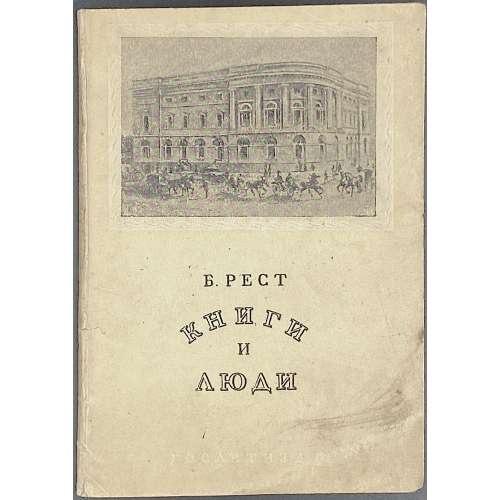 Softcover, original wrappers, 16 x 11 cm, collated 8vo: 48, 54, total 36 leaves, pp.: [2] 3-71 [72]. Front wrapper (lettered in black and white): {photo} | Б. РЕСТ. | КНИГИ | И | ЛЮДИ | ГОСЛИТИЗДАТ || Title-page (black and red): Б. РЕСТ | КНИГИ И ЛЮДИ | ОЧЕРКИ ИЗ ИСТОРИИ ГОСУДАРСТВЕННОЙ | ПУБЛИЧНОЙ БИБЛИОТЕКИ | имени | М. Е. САЛТЫКОВА-ЩЕДРИНА | 1814 — 1939 | {vignette} | — | Государственное издательство | “ХУДОЖЕСТВЕННАЯ ЛИТЕРАТУРА” | Ленинград 1939 || Print run: 7,500 copies. B. Rest [Б. Рест; Юлий Исаакович Шапиро] (Jewish-Russian, fl. 1940 – 1980).
Softcover, original wrappers, 16 x 11 cm, collated 8vo: 48, 54, total 36 leaves, pp.: [2] 3-71 [72]. Front wrapper (lettered in black and white): {photo} | Б. РЕСТ. | КНИГИ | И | ЛЮДИ | ГОСЛИТИЗДАТ || Title-page (black and red): Б. РЕСТ | КНИГИ И ЛЮДИ | ОЧЕРКИ ИЗ ИСТОРИИ ГОСУДАРСТВЕННОЙ | ПУБЛИЧНОЙ БИБЛИОТЕКИ | имени | М. Е. САЛТЫКОВА-ЩЕДРИНА | 1814 — 1939 | {vignette} | — | Государственное издательство | “ХУДОЖЕСТВЕННАЯ ЛИТЕРАТУРА” | Ленинград 1939 || Print run: 7,500 copies. B. Rest [Б. Рест; Юлий Исаакович Шапиро] (Jewish-Russian, fl. 1940 – 1980). -
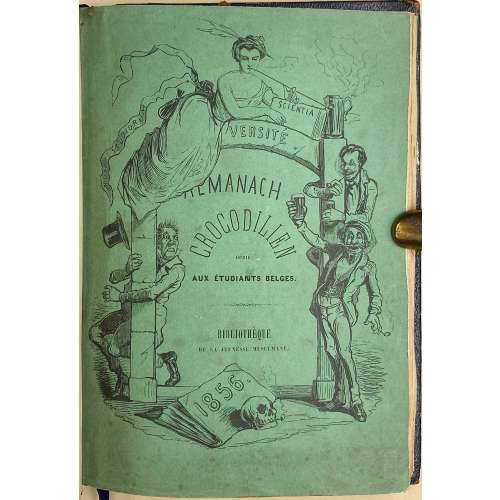 One volume collated 8vo, 19 x 14 cm, bound in black alligator leather. Front wrapper (green) / title-page (white): A female figure smoking a pipe next to a beer mug, reclining over an arch ring lettered “…VERSITÉ” (UNI… not shown), her dress ribbon lettered “MUSA STUDIORUM”, holding a book lettered “SCIENTIA”; within the arch « ALMANACH | CROCODILIEN | DÉDIÉ | AUX ÉTUDIANTS BELGES. | BIBLIOTHÈQUE | DE LA JEUNESSE MUSULMANE. »; below lies a book lettered “1856.”, next to it is a smoking skull; three male figures embracing the arch columns. Half-title: ALMANACH CROCODILIEN | POUR | L’ANNÉE BISSEXTILE, MAIS NÉANMOINS DE GRACE | 1856. || Pagination: [1-5] 6-14 [15-41] 42-134 [137] 138, total 136 pages within the wrappers, original publisher's green wrappers preserved, carte de visite ‘Félicien Rops, Étudiant’ and pink invitation card № 129 for ‘Bal des femmes’ on March 19, 1892 at ‘Fête annuelle du Courier Français’ bound in; in-text woodcuts, initials, head- and tail-pieces after Félicien Rops. Bookplate “Ex Libris Marcellus Schlimovich” with motto “Ars naturam adiuvat” on front pastedown. Stamp of the "Sociedad Hebraica Argentina / Coleccion M. Schlimovich / Varios / No. 2-492” to half-title. Pencil inscription to half-title: "Ex. Félicien Rops" – possibly an own copy of the artist. Collation: π2 1-88 92, total 68 leaves within wrappers. Printer: Typ. de J. Vanbuggenhoudt (Bruxelles). Sociedad Hebraica Argentina; Marcelo Schlimovich (Argentine-Jewish, ca. 1880 – 1960) – provenance. Félicien Rops (Belgian, 1833 – 1898) – artist.
One volume collated 8vo, 19 x 14 cm, bound in black alligator leather. Front wrapper (green) / title-page (white): A female figure smoking a pipe next to a beer mug, reclining over an arch ring lettered “…VERSITÉ” (UNI… not shown), her dress ribbon lettered “MUSA STUDIORUM”, holding a book lettered “SCIENTIA”; within the arch « ALMANACH | CROCODILIEN | DÉDIÉ | AUX ÉTUDIANTS BELGES. | BIBLIOTHÈQUE | DE LA JEUNESSE MUSULMANE. »; below lies a book lettered “1856.”, next to it is a smoking skull; three male figures embracing the arch columns. Half-title: ALMANACH CROCODILIEN | POUR | L’ANNÉE BISSEXTILE, MAIS NÉANMOINS DE GRACE | 1856. || Pagination: [1-5] 6-14 [15-41] 42-134 [137] 138, total 136 pages within the wrappers, original publisher's green wrappers preserved, carte de visite ‘Félicien Rops, Étudiant’ and pink invitation card № 129 for ‘Bal des femmes’ on March 19, 1892 at ‘Fête annuelle du Courier Français’ bound in; in-text woodcuts, initials, head- and tail-pieces after Félicien Rops. Bookplate “Ex Libris Marcellus Schlimovich” with motto “Ars naturam adiuvat” on front pastedown. Stamp of the "Sociedad Hebraica Argentina / Coleccion M. Schlimovich / Varios / No. 2-492” to half-title. Pencil inscription to half-title: "Ex. Félicien Rops" – possibly an own copy of the artist. Collation: π2 1-88 92, total 68 leaves within wrappers. Printer: Typ. de J. Vanbuggenhoudt (Bruxelles). Sociedad Hebraica Argentina; Marcelo Schlimovich (Argentine-Jewish, ca. 1880 – 1960) – provenance. Félicien Rops (Belgian, 1833 – 1898) – artist. -
 An uncut fan print showing Otsu-e [大津絵] (Otsu pictures). Artist: Utagawa Sadahide [歌川貞秀] (Japanese, 1807 – 1879). Signed: Gountei Sadahide ga [五雲亭貞秀画] (Picture by Gountei Sadahide); characters on the Otsu-e. Publisher: Ibaya Senzaburō [伊場屋仙三郎] (Japanese, c. 1815 – 1869). Published: c. 1849. Inscription in a paper-weight shaped cartouche: [大津追 分絵の図] Ōtsu-oi wake-e no zu (Following Otsu – image of separate pictures) No date seal, no censor seal (privately printed?) Media: Fan print (uchiwa-e, 団扇絵), 235 x 298 mm.
An uncut fan print showing Otsu-e [大津絵] (Otsu pictures). Artist: Utagawa Sadahide [歌川貞秀] (Japanese, 1807 – 1879). Signed: Gountei Sadahide ga [五雲亭貞秀画] (Picture by Gountei Sadahide); characters on the Otsu-e. Publisher: Ibaya Senzaburō [伊場屋仙三郎] (Japanese, c. 1815 – 1869). Published: c. 1849. Inscription in a paper-weight shaped cartouche: [大津追 分絵の図] Ōtsu-oi wake-e no zu (Following Otsu – image of separate pictures) No date seal, no censor seal (privately printed?) Media: Fan print (uchiwa-e, 団扇絵), 235 x 298 mm. -
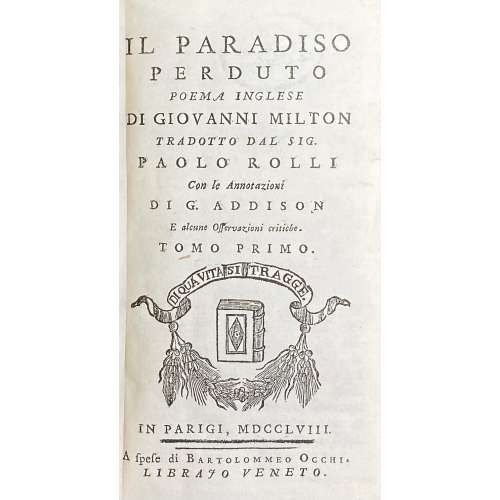 Quarter calf over marbled boards, 16 x 9 cm, spine with raised bands, gilt in compartments, gilt-lettered label, all margins red, two title-pages (one for each vol.), illustrated with engraved frontispiece by Antonio Baratti after Antonio Balestra; engraved portrait of John Milton by Antonio Baratti, 12 plates, one for each book, after “Piazzetta, Zucchi, Balestra, Tiepolo, and other Venetian artists”, unsigned; plate II signed ‘Antonio Barati scul.’ Title page: IL PARADISO | PERDUTO | POEMA INGLESE | DI GIOVANNI MILTON | TRADOTTO DAL SIG. | PAOLO ROLLI | Con le Annotazioni | DI G. ADDISON | E alcune Osservazioni critiche. | TOMO PRIMO (SECUNDO). | {publisher’s device} | IN PARIGI , MDCCLVIII. | — | A spese di Bartolommeo Occhi. | LIBRAJO VENETO. || Collation: *-**12 ***8 (dedication, vita), A-R12 (vol. 1) A-K12 L9 (vol.2); total 365 leaves plus 14 engraved plates, incl. frontispiece and portrait. Pagination: [i, ii] iii-lxiv 1-407 [408 blank], [2] 3-258; total 730 pages. Catalogue raisonné: Wickenheiser Collection 688 [LIB-2795.2021]. Though it states 228 pp., which does not seem right. “Scarce. Not in Coleridge”. Contributors: Milton, John (British, 1608 – 1674) – author. Joseph Addison (British, 1672 – 1719) – author / criticism Paolo Antonio Rolli (Italian, 1687 – 1765) – author / transaltion Bartolomeo Occhi (Italian, 1730 – 1781) – publisher. Antonio Baratti (Italian, 1724 – 1787) – engraver Antonio Balestra (Italian, 1666 – 1740) – artist. Giovanni Battista Piazzetta (Italian,1682/83 – 1754) – artist. Antonio Zucchi (Italian, 1726 – 1795) – artist. Giovanni Battista Tiepolo (Italian, 1696 – 1770) – artist.
Quarter calf over marbled boards, 16 x 9 cm, spine with raised bands, gilt in compartments, gilt-lettered label, all margins red, two title-pages (one for each vol.), illustrated with engraved frontispiece by Antonio Baratti after Antonio Balestra; engraved portrait of John Milton by Antonio Baratti, 12 plates, one for each book, after “Piazzetta, Zucchi, Balestra, Tiepolo, and other Venetian artists”, unsigned; plate II signed ‘Antonio Barati scul.’ Title page: IL PARADISO | PERDUTO | POEMA INGLESE | DI GIOVANNI MILTON | TRADOTTO DAL SIG. | PAOLO ROLLI | Con le Annotazioni | DI G. ADDISON | E alcune Osservazioni critiche. | TOMO PRIMO (SECUNDO). | {publisher’s device} | IN PARIGI , MDCCLVIII. | — | A spese di Bartolommeo Occhi. | LIBRAJO VENETO. || Collation: *-**12 ***8 (dedication, vita), A-R12 (vol. 1) A-K12 L9 (vol.2); total 365 leaves plus 14 engraved plates, incl. frontispiece and portrait. Pagination: [i, ii] iii-lxiv 1-407 [408 blank], [2] 3-258; total 730 pages. Catalogue raisonné: Wickenheiser Collection 688 [LIB-2795.2021]. Though it states 228 pp., which does not seem right. “Scarce. Not in Coleridge”. Contributors: Milton, John (British, 1608 – 1674) – author. Joseph Addison (British, 1672 – 1719) – author / criticism Paolo Antonio Rolli (Italian, 1687 – 1765) – author / transaltion Bartolomeo Occhi (Italian, 1730 – 1781) – publisher. Antonio Baratti (Italian, 1724 – 1787) – engraver Antonio Balestra (Italian, 1666 – 1740) – artist. Giovanni Battista Piazzetta (Italian,1682/83 – 1754) – artist. Antonio Zucchi (Italian, 1726 – 1795) – artist. Giovanni Battista Tiepolo (Italian, 1696 – 1770) – artist. -
 Artist: Utagawa Kunisada, a.k.a. Toyokuni III (Japanese, 1786 – 1865) [歌川 国貞]. Publisher: Ibaya Senzaburō [伊場屋仙三郎] (Japanese, fl. C. 1845 – 1847). Date aratame seal: Bunsei 12 (1829). Signed: Gototei Kunisada ga [五渡亭国貞画]. Media: Fan print (uchiwa-e), 238 x 267 mm (overtrimmed). Actor: Iwai Shijaku I [紫若] (Japanese, 1804 – 1845); other names: Iwai Matsunosuke I [岩井松之助]; Iwai Hanshirō VII, Iwai Shijaku I, Iwai Komurasaki I. The background is Arare-ko-mon [霰小紋] hail pattern. In the red cartouche at the top right is the series title "Edo no hana – itsutsu Karigane" (江戸の花 五雁金), to be translated as "Flowers of Edo - the five Karigane blood-brothers" (or "the five Karigane gang members"). Another print from the series in this collection: SVJP-0304.2019.
Artist: Utagawa Kunisada, a.k.a. Toyokuni III (Japanese, 1786 – 1865) [歌川 国貞]. Publisher: Ibaya Senzaburō [伊場屋仙三郎] (Japanese, fl. C. 1845 – 1847). Date aratame seal: Bunsei 12 (1829). Signed: Gototei Kunisada ga [五渡亭国貞画]. Media: Fan print (uchiwa-e), 238 x 267 mm (overtrimmed). Actor: Iwai Shijaku I [紫若] (Japanese, 1804 – 1845); other names: Iwai Matsunosuke I [岩井松之助]; Iwai Hanshirō VII, Iwai Shijaku I, Iwai Komurasaki I. The background is Arare-ko-mon [霰小紋] hail pattern. In the red cartouche at the top right is the series title "Edo no hana – itsutsu Karigane" (江戸の花 五雁金), to be translated as "Flowers of Edo - the five Karigane blood-brothers" (or "the five Karigane gang members"). Another print from the series in this collection: SVJP-0304.2019. -
 Paperback volume, 25.7 x 18.6 cm, brown embossed wrappers with framed Japanese characters along the outer margin, pictorial dust jacket with series design (black lettering and vignette in silver border to wrappers, black lettering on silver to spine); pp: [1-6]: h.t./frontis. (colour plate pasted in), t.p./imprint, contents/blank), 7-32 text, 33-96 (59 plates w/captions). Title-page (in frame): MASTERWORKS OF UKIYO-E | EARLY PAINTINGS | by Muneshige Narazaki | English adaptation by Charles A. Pomeroy | {publisher’s device} | KODANSHA INTERNATIONAL LTD. | Tokyo, Japan & Palo-Alto, Calif., U.S.A | {vertical between rules 初期 浮世絵} || Series: Masterworks of ukiyo-e, № 1. Contributors: Muneshige Narazaki [楢崎 宗重] (Japanese, 1904 – 2001) – author. Charles A. Pomeroy (American, b. 1930) – adaptation.
Paperback volume, 25.7 x 18.6 cm, brown embossed wrappers with framed Japanese characters along the outer margin, pictorial dust jacket with series design (black lettering and vignette in silver border to wrappers, black lettering on silver to spine); pp: [1-6]: h.t./frontis. (colour plate pasted in), t.p./imprint, contents/blank), 7-32 text, 33-96 (59 plates w/captions). Title-page (in frame): MASTERWORKS OF UKIYO-E | EARLY PAINTINGS | by Muneshige Narazaki | English adaptation by Charles A. Pomeroy | {publisher’s device} | KODANSHA INTERNATIONAL LTD. | Tokyo, Japan & Palo-Alto, Calif., U.S.A | {vertical between rules 初期 浮世絵} || Series: Masterworks of ukiyo-e, № 1. Contributors: Muneshige Narazaki [楢崎 宗重] (Japanese, 1904 – 2001) – author. Charles A. Pomeroy (American, b. 1930) – adaptation. -
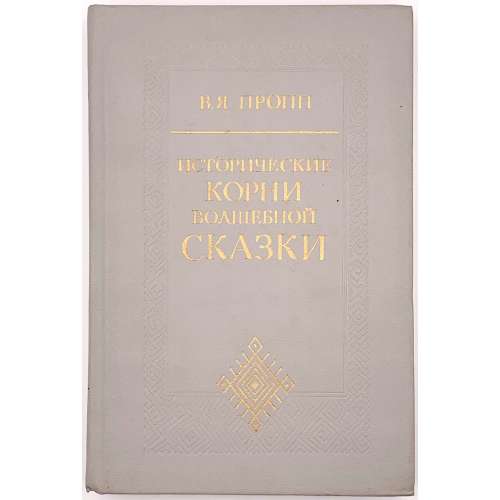 Hardcover volume, 22.2 x 14.8 cm, bound in grey buckram, gilt lettering in an ornamental frame to front and spine, blind-stamped lettering to back; pp.: [1-2] 3-364 [4], collated 8vo:1-238, total 184 leaves, 368 pages. Title-page: ЛЕНИНГАДСКИЙ ОРДЕНА ЛЕНИНА | И ОРДЕНА ТРУДОВОГО КРАСНОГО ЗНАМЕНИ | ГОСУДАРСТВЕННЫЙ УНИВЕРСИТЕТ ИМЕНИ А. А. ЖДАНОВА | {in two-compartment frame: В. Я. ПРОПП {within a compartment} | ИСТОРИЧЕСКИЕ КОРНИ ВОЛШЕБНОЙ СКАЗКИ {within a compartment} | ИЗДАТЕЛЬСТВО ЛЕНИНГРАДСКОГО УНИВЕРСИТЕТА | ЛЕНИНГРАД 1986 || Print run: 25,000 copies. Edition: 2nd edition; for the 1st edition, see [LIB-3184.2023] В. Я. Пропп. Исторические корни волшебной сказки. — Л.: ЛГУ, 1946. English title: [LIB-1615.2018] The historical roots of the fairy tale. Contributors: Владимир Яковлевич Пропп [Vladimir Propp] (Russian, 1895 – 1970)
Hardcover volume, 22.2 x 14.8 cm, bound in grey buckram, gilt lettering in an ornamental frame to front and spine, blind-stamped lettering to back; pp.: [1-2] 3-364 [4], collated 8vo:1-238, total 184 leaves, 368 pages. Title-page: ЛЕНИНГАДСКИЙ ОРДЕНА ЛЕНИНА | И ОРДЕНА ТРУДОВОГО КРАСНОГО ЗНАМЕНИ | ГОСУДАРСТВЕННЫЙ УНИВЕРСИТЕТ ИМЕНИ А. А. ЖДАНОВА | {in two-compartment frame: В. Я. ПРОПП {within a compartment} | ИСТОРИЧЕСКИЕ КОРНИ ВОЛШЕБНОЙ СКАЗКИ {within a compartment} | ИЗДАТЕЛЬСТВО ЛЕНИНГРАДСКОГО УНИВЕРСИТЕТА | ЛЕНИНГРАД 1986 || Print run: 25,000 copies. Edition: 2nd edition; for the 1st edition, see [LIB-3184.2023] В. Я. Пропп. Исторические корни волшебной сказки. — Л.: ЛГУ, 1946. English title: [LIB-1615.2018] The historical roots of the fairy tale. Contributors: Владимир Яковлевич Пропп [Vladimir Propp] (Russian, 1895 – 1970) -
 Hardcover volume, 23 x 15 cm, bound in full pictorial olive cloth, lettering to spine, in a green slipcase 23.5 x 15.9 cm; pp.: [1-4] 5- 267 [268] [4 blanks], b/w tailpieces, frontispiece and 8 colour photomechanical plates after John Holder. Title-page: GRAHAM GREENE | TRAVELS WITH MY AUNT | A Novel | Introduced by John Mortimer | Illustrated by John Holder | FOLIO SOCIETY | LONDON MMIV || Contributors: Graham Greene (British, 1904 – 1991) – author. John Mortimer (British, 1923 – 2009) – author/introduction. John Holder (British, b. 1941) – artist. St. Edmundsbury Press (UK) – printer. Hunter & Fouls (Haddington) – binder. Folio Society (UK) – publisher. For the 1st edition, see [LIB-2758.2021] Graham Greene. Travels with my aunt: a novel. — London: Bodley Head, 1969.
Hardcover volume, 23 x 15 cm, bound in full pictorial olive cloth, lettering to spine, in a green slipcase 23.5 x 15.9 cm; pp.: [1-4] 5- 267 [268] [4 blanks], b/w tailpieces, frontispiece and 8 colour photomechanical plates after John Holder. Title-page: GRAHAM GREENE | TRAVELS WITH MY AUNT | A Novel | Introduced by John Mortimer | Illustrated by John Holder | FOLIO SOCIETY | LONDON MMIV || Contributors: Graham Greene (British, 1904 – 1991) – author. John Mortimer (British, 1923 – 2009) – author/introduction. John Holder (British, b. 1941) – artist. St. Edmundsbury Press (UK) – printer. Hunter & Fouls (Haddington) – binder. Folio Society (UK) – publisher. For the 1st edition, see [LIB-2758.2021] Graham Greene. Travels with my aunt: a novel. — London: Bodley Head, 1969. -
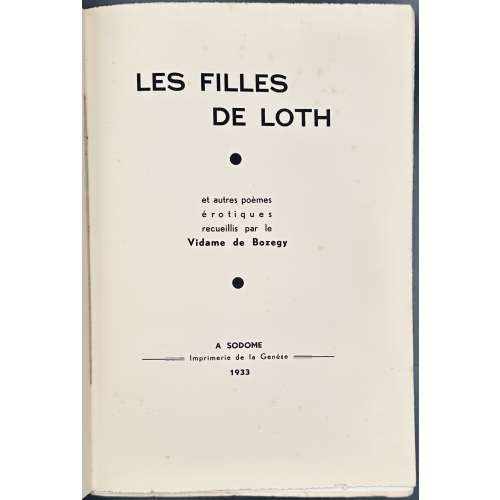 Softcover, french flapped wrappers, 29 x 19 cm, in glassine dustjacket, text printed on laid paper, pp.: [1-10] 11-256 [8], total 264 pages plus 11 plates out of 12, hand-coloured etchings on wove paper laid in, extraneous to collation. Wrappers detached from the block. Some pages uncut. Below is the missing plate, according to honesterotica.com:
Softcover, french flapped wrappers, 29 x 19 cm, in glassine dustjacket, text printed on laid paper, pp.: [1-10] 11-256 [8], total 264 pages plus 11 plates out of 12, hand-coloured etchings on wove paper laid in, extraneous to collation. Wrappers detached from the block. Some pages uncut. Below is the missing plate, according to honesterotica.com: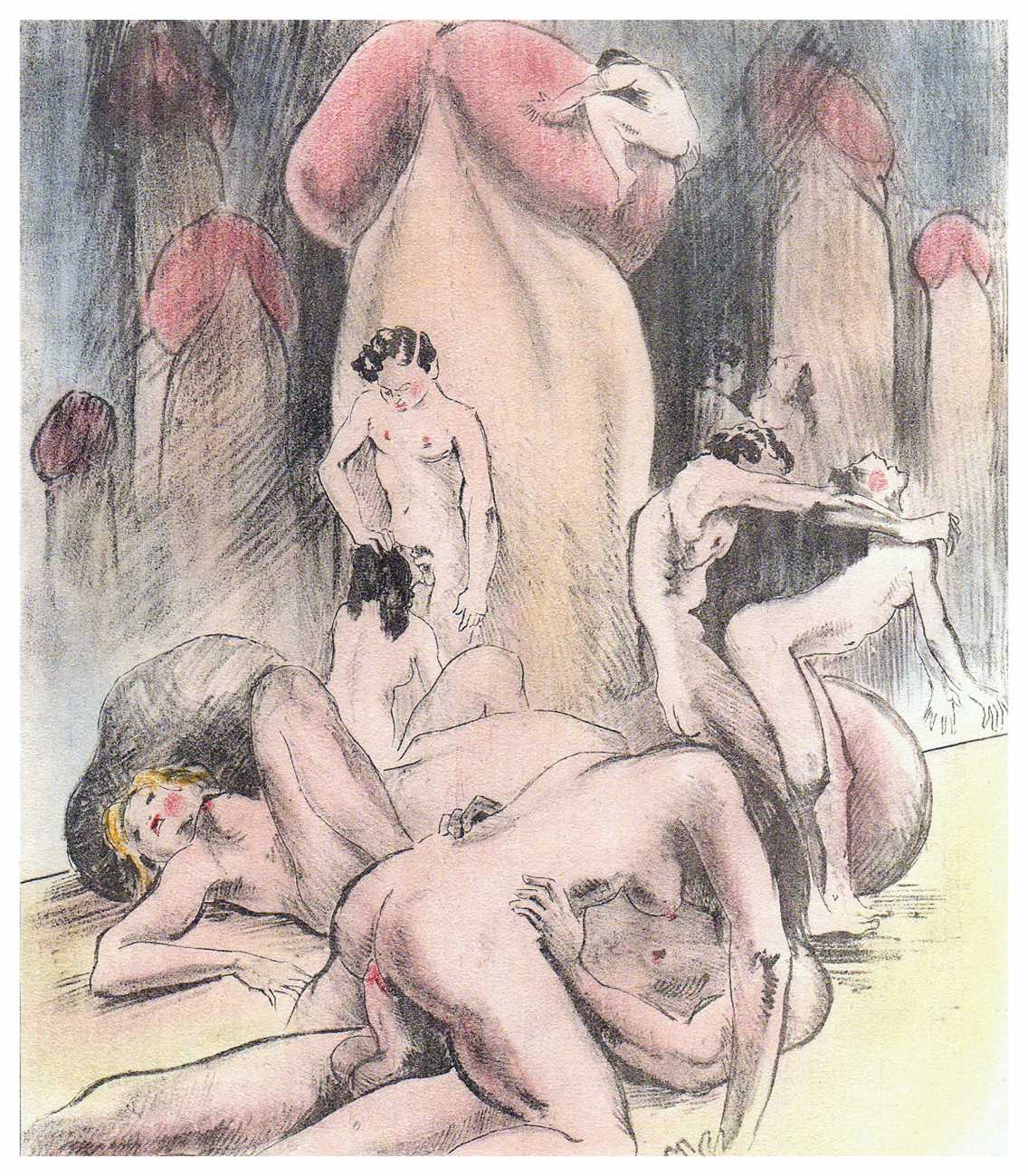 Title-page: LES FILLES | DE LOTH | • | et autres poèmes | érotiques | recueillis par le | Vidame de Bozegy | • | A SODOME | — Imprimerie de la Genèse — | 1933 ||
Edition limited to 500 copies, this is copy № 54.
Catalogue raisonné: Dutel III № 1575.
Edmond Dardenne Bernard [Vidame de Bozegy] (French, 20th c.) – author.
André Collot (French, 1897 – 1976) – artist.
Title-page: LES FILLES | DE LOTH | • | et autres poèmes | érotiques | recueillis par le | Vidame de Bozegy | • | A SODOME | — Imprimerie de la Genèse — | 1933 ||
Edition limited to 500 copies, this is copy № 54.
Catalogue raisonné: Dutel III № 1575.
Edmond Dardenne Bernard [Vidame de Bozegy] (French, 20th c.) – author.
André Collot (French, 1897 – 1976) – artist. -
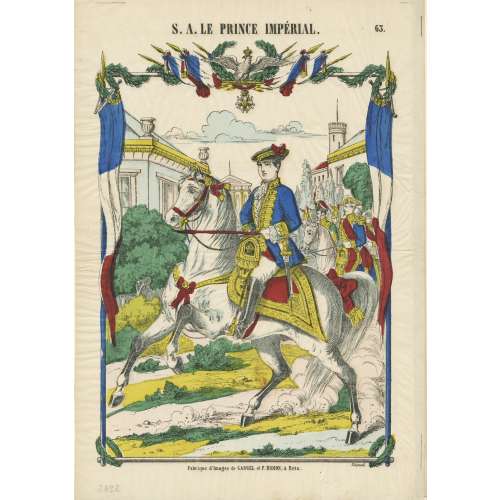 Hand-coloured woodcut on wove paper, 327 x 280 mm; black ink stamp “5265” to reverse, attached to the sheet 470 x 325 mm. Top centre: "S. A. LE PRINCE IMPÉRIAL.", right: "63." Image: equestiral portrait of Prince Impérial. Under the image, centre: "Fabrique d'Images de GANGEL et P. DIDION, à Metz." — "Déposé." Napoléon, Prince Imperial (Napoléon Eugène Louis Jean Joseph Bonaparte] (French, 1856 – 1879). Gangel et P. Didion (Metz); Paulin Didion (French, 1831 – 1879) – publisher/printer.
Hand-coloured woodcut on wove paper, 327 x 280 mm; black ink stamp “5265” to reverse, attached to the sheet 470 x 325 mm. Top centre: "S. A. LE PRINCE IMPÉRIAL.", right: "63." Image: equestiral portrait of Prince Impérial. Under the image, centre: "Fabrique d'Images de GANGEL et P. DIDION, à Metz." — "Déposé." Napoléon, Prince Imperial (Napoléon Eugène Louis Jean Joseph Bonaparte] (French, 1856 – 1879). Gangel et P. Didion (Metz); Paulin Didion (French, 1831 – 1879) – publisher/printer. -
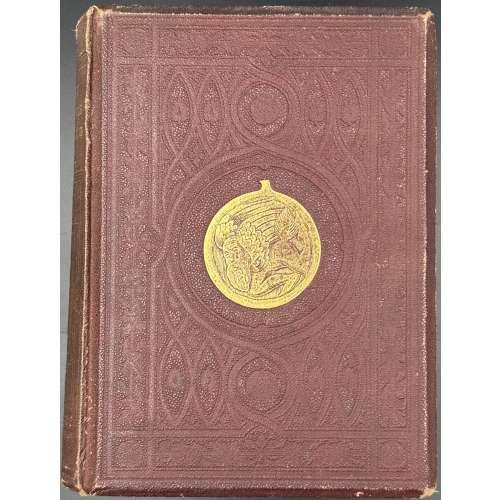 Hardcover, 23 x 17 x 4.7 cm, burgundy buckram, bevelled boards, blind geometrical design with a gilt medallion at the centre, gilt lettering and blind design elements to spine, text in frame, all edges red; pp.: [i-v] vi-xvi, [1] 2-494, [2 advert.], [1] 2-32 advert.], collation 4to: a-b4, B-3R4, a16. Title-page (red and black, in red frame): A HISTORY | OF | CARICATURE & GROTESQUE | {gothic letters} In Literature and Art. | By THOMAS WRIGHT, Esq., M.A., F.S.A., | Hon. M.R.S.L., &c.; | Corresponding Member of the Imperial Institute of France | (Académie des Inscriptions et Belles Lettres). |{double rules} | WITH | ILLUSTRATIONS FROM VARIOUS SOURCES, | DRAWN AND ENGRAVED BY | F. W. FAIRHOLT, Esq., F.S.A. | {double rules} | {gothic letters} London : | VIRTUE BROTHERS & CO., 1, AMEN CORNER, | PATERNOSTER ROW. | 1865. Contributors : Thomas Wright (British, 1792 – 1849) – author. Frederick William Fairholt (British, 1814 – 1866) – artist/engraver. Virtue Brothers & Co. (London) – publisher/printer.
Hardcover, 23 x 17 x 4.7 cm, burgundy buckram, bevelled boards, blind geometrical design with a gilt medallion at the centre, gilt lettering and blind design elements to spine, text in frame, all edges red; pp.: [i-v] vi-xvi, [1] 2-494, [2 advert.], [1] 2-32 advert.], collation 4to: a-b4, B-3R4, a16. Title-page (red and black, in red frame): A HISTORY | OF | CARICATURE & GROTESQUE | {gothic letters} In Literature and Art. | By THOMAS WRIGHT, Esq., M.A., F.S.A., | Hon. M.R.S.L., &c.; | Corresponding Member of the Imperial Institute of France | (Académie des Inscriptions et Belles Lettres). |{double rules} | WITH | ILLUSTRATIONS FROM VARIOUS SOURCES, | DRAWN AND ENGRAVED BY | F. W. FAIRHOLT, Esq., F.S.A. | {double rules} | {gothic letters} London : | VIRTUE BROTHERS & CO., 1, AMEN CORNER, | PATERNOSTER ROW. | 1865. Contributors : Thomas Wright (British, 1792 – 1849) – author. Frederick William Fairholt (British, 1814 – 1866) – artist/engraver. Virtue Brothers & Co. (London) – publisher/printer. -
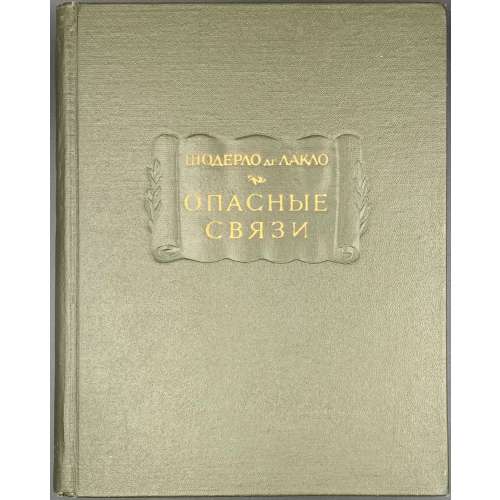 NEWHardcover, 220 x 180 mm, green buckram with gilt lettering on an embossed scroll to front cover and faded gilt lettering to spine (serial design), collated 8vo: 1-208 2110 228 (i.e. 178 leaves), pp. [1-4] 5-354 [2], errata slip laid in before back ffl. Title-page (red and black): ШОДЕРЛО де ЛАКЛО | ~ | ОПАСНЫЕ | СВЯЗИ | ~ | ПЕРЕВОД С ФРАНЦУЗСКОГО, | СТАТЬЯ И ПРИМЕЧАНИЯ | Н. Я. РЫКОВОЙ | ~ | ИЗДАТЕЛЬСТВО «НАУКА» | МОСКВА • ЛЕНИНГРАД | 1965 || Opposite t.p. (red and black): CHODERLOS de LACLOS | ~ | LES LIAISONS | DANGEREUSES | OU | LETTRES RECUEILLIES | DANS UNE SOCIÉTÉ | ET PUBLIÉES POUR L’INSTRUCTION | DE QUELQUES AUTRES | ~ || Series: АН СССР, Литературные памятники. Contributors: Choderlos de Laclos, Pierre Ambroise François (French, 1741 – 1803) – author. Рыкова, Надежда Януарьевна (Russian, 1901 – 1996) – translator Молок, Александр Иванович (Russian, 1898 – 1977) : Дворянство во Франции накануне буржуазной революции XVII века (pp. 317-335).
NEWHardcover, 220 x 180 mm, green buckram with gilt lettering on an embossed scroll to front cover and faded gilt lettering to spine (serial design), collated 8vo: 1-208 2110 228 (i.e. 178 leaves), pp. [1-4] 5-354 [2], errata slip laid in before back ffl. Title-page (red and black): ШОДЕРЛО де ЛАКЛО | ~ | ОПАСНЫЕ | СВЯЗИ | ~ | ПЕРЕВОД С ФРАНЦУЗСКОГО, | СТАТЬЯ И ПРИМЕЧАНИЯ | Н. Я. РЫКОВОЙ | ~ | ИЗДАТЕЛЬСТВО «НАУКА» | МОСКВА • ЛЕНИНГРАД | 1965 || Opposite t.p. (red and black): CHODERLOS de LACLOS | ~ | LES LIAISONS | DANGEREUSES | OU | LETTRES RECUEILLIES | DANS UNE SOCIÉTÉ | ET PUBLIÉES POUR L’INSTRUCTION | DE QUELQUES AUTRES | ~ || Series: АН СССР, Литературные памятники. Contributors: Choderlos de Laclos, Pierre Ambroise François (French, 1741 – 1803) – author. Рыкова, Надежда Януарьевна (Russian, 1901 – 1996) – translator Молок, Александр Иванович (Russian, 1898 – 1977) : Дворянство во Франции накануне буржуазной революции XVII века (pp. 317-335). -

Жуковский Ю. Г. Политические и общественные теории XVI-го века. - С.Петербург, 1866. Типография А. Головачева. // Материалы для общественной науки. - 163 с.
Схоластика.
Макиавелли и Томас Мор.
Реформация: Лютер, Кальвин, анабаптисты.
Жан Боден.
[Штамп на титуле: A. Namoradze, Tiflis. 1935.]
-
 UTAGAWA TOYOKUNI I (1769–1825) Ichikawa Danjūrō VII (Ebizo V) in a shibaraku costume bursting through a paper screen. Surimono. Colour woodblock print: shikishiban, 8⅛ x 7⅛ in. (20.7 x 18.2 cm) Signed: Toyokuni ga Poem signed: Sakuragawa Jihinari Provenance: Sidney C. Ward
UTAGAWA TOYOKUNI I (1769–1825) Ichikawa Danjūrō VII (Ebizo V) in a shibaraku costume bursting through a paper screen. Surimono. Colour woodblock print: shikishiban, 8⅛ x 7⅛ in. (20.7 x 18.2 cm) Signed: Toyokuni ga Poem signed: Sakuragawa Jihinari Provenance: Sidney C. Ward -
 Iron tsuba of slightly elongated round form decorated with design of melon flowers, vines, and leaves in brass flat inlay (hira-zōgan) on both sides. Slightly raised rim (mimi) carved in a way to simulate ring-shaped covering (fukurin). Kozuka hitsu-ana and kogai hitsu-ana both plugged with soft metal (tim or lead). Copper sekigane. Heianjō or Kaga School. Muromachi or Momoyama period, 16th century. Iron, hira-zōgan brass inlay. Round (maru gata) form, diameter 79 mm. Size: 80.3 x 78.4 mm; thickness at seppa-dai: 3.4 mm; at the middle: 3.8 mm; before the rim: 2.4 mm, rim: 2.8 mm. Note on design: though this design resembles family crests with oak and mulberry leaves, I believe it's a melon flower [see Jeanne Allen. Designer's guide to Samurai Patterns. Chronicle Books, San Francisco, 1990, page 114, №130 "Melon Flowers":Note about the distribution of thickness (niku-oki): "this tsuba has toroid features, niku raises from the rim towards the centre but thins once more out when approaching the seppa-dai" [M. Sesko, "Handbook...", p. 48].
Iron tsuba of slightly elongated round form decorated with design of melon flowers, vines, and leaves in brass flat inlay (hira-zōgan) on both sides. Slightly raised rim (mimi) carved in a way to simulate ring-shaped covering (fukurin). Kozuka hitsu-ana and kogai hitsu-ana both plugged with soft metal (tim or lead). Copper sekigane. Heianjō or Kaga School. Muromachi or Momoyama period, 16th century. Iron, hira-zōgan brass inlay. Round (maru gata) form, diameter 79 mm. Size: 80.3 x 78.4 mm; thickness at seppa-dai: 3.4 mm; at the middle: 3.8 mm; before the rim: 2.4 mm, rim: 2.8 mm. Note on design: though this design resembles family crests with oak and mulberry leaves, I believe it's a melon flower [see Jeanne Allen. Designer's guide to Samurai Patterns. Chronicle Books, San Francisco, 1990, page 114, №130 "Melon Flowers":Note about the distribution of thickness (niku-oki): "this tsuba has toroid features, niku raises from the rim towards the centre but thins once more out when approaching the seppa-dai" [M. Sesko, "Handbook...", p. 48].
Jeanne Allen. Designer's guide to Samurai Patterns. Chronicle Books, San Francisco, 1990. Page 114, №130.
-
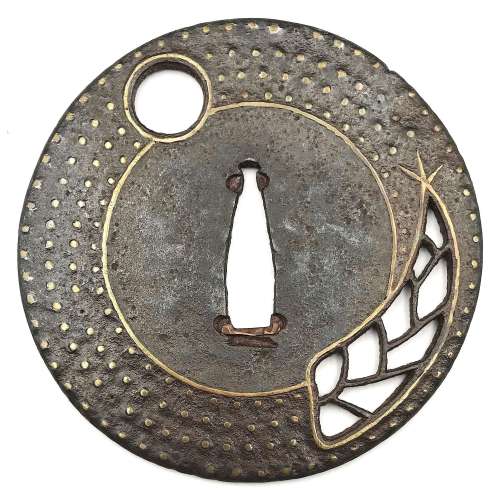 Ōnin shinchū ten-zōgan tsuba. Iron tsuba of round form decorated with full moon and bamboo shoot (takenoko) motif executed in openwork (sukashi) and inlaid with four concentric rows of brass dots (ten-zōgan). The innermost row of dots as well as the sukashi openings outlined with the inlaid linear brass wire. Late Muromachi period, 16th century. Diameter: 82.0 mm; Thickness: 2.8 mm Cited from Merrily Baird. Symbols of Japan. Thematic motifs in art and design. Rizzoli international publications, Inc., 2001, p. 72: "In Japanese art, the appearance of bamboo shoots is often without symbolic meaning. In other cases, however, the shoots are emblematic of Moso (Chinese: Meng Tsung/Meng Zong), a paragon of filial piety who dug through snow to find shoots for his mother. ... especially in miniature art forms, let bamboo shoots alone speak for the full story." The full story is this (See THE TWENTY-FOUR PARAGONS OF FILIAL PIETY [ERSHISI XIAO]):
Ōnin shinchū ten-zōgan tsuba. Iron tsuba of round form decorated with full moon and bamboo shoot (takenoko) motif executed in openwork (sukashi) and inlaid with four concentric rows of brass dots (ten-zōgan). The innermost row of dots as well as the sukashi openings outlined with the inlaid linear brass wire. Late Muromachi period, 16th century. Diameter: 82.0 mm; Thickness: 2.8 mm Cited from Merrily Baird. Symbols of Japan. Thematic motifs in art and design. Rizzoli international publications, Inc., 2001, p. 72: "In Japanese art, the appearance of bamboo shoots is often without symbolic meaning. In other cases, however, the shoots are emblematic of Moso (Chinese: Meng Tsung/Meng Zong), a paragon of filial piety who dug through snow to find shoots for his mother. ... especially in miniature art forms, let bamboo shoots alone speak for the full story." The full story is this (See THE TWENTY-FOUR PARAGONS OF FILIAL PIETY [ERSHISI XIAO]):Tears That Brought Bamboo-shoots From the Frozen Earth: Meng Zong Meng Zong lived during the Three Kingdoms Period of China's past. His father died when he was young, and he and his mother struggled to survive. One winter his mother was stricken with a serious illness, and craved some bamboo-shoot broth as medicine. But in the depths of winter, with snow and ice blanketing the ground, where was anyone to find fresh bamboo shoots, shoots that emerge only in the warm months? Nonetheless, Meng Zong, to avoid disappointing his mother, bravely fetched his shovel and went out into the white landscape in search of bamboo shoots. In the thicket he found only frosted leaves and green stalks coated with snowflakes and ice. Look as he might, there were simply no fresh shoots growing in the winter. The thought of his poor mother lying sick on her bed, waiting for bamboo-broth medicine, made his heartache. Uncontrollably, tears began to fall in rivers to the ground beneath the tall, emerald canes. Even now, as his tears flowed down, he kept a light of faith in his heart. If he was truly sincere in his search, perhaps.... Just then Meng Zong nearly tripped and fell over a sharply protruding lump of earth. He quickly knelt down and knocked aside the dirt with his trembling fingers. How uncanny! Underneath his frozen hands he discovered a bed of fresh, tender bamboo shoots! Overjoyed, he gathered up a coatful and carried them back home. The broth that he quickly set stewing in the pot soon cured his mother's illness. The neighbors, hearing the story, exclaimed that it was the strength of his sincere, unselfish, filial resolve that inspired heaven and earth to respond, and to bring up, out of season, the fresh shoots that cured his mother's disease. Before Meng Zong's prayers generated this miracle, it was normally considered impossible for bamboo shoots to grow in the winter. After the nmiracle took place, however, people were able to gather and to eat bamboo shoots all year round. The winter variety that existed hereafter became known as "winter shoots." The villagers were deeply influenced by Meng Zong's courage and devotion. They renamed the spot where the event took place, "Meng Zong's Bamboo Grove". We can now enjoy bamboo sprouts during the winter as well, and as we do so, it is fitting to recollect Meng Zong's outstanding example of filial respect, and reflect on our conduct as sons and daughter of our parents. A verse in his honor says, His teardrops transformed winter at the roots; Up from the ice crept tender bamboo shoots. Instantly, the winter-sprouts matured; Heaven's will: a happy, peaceful world.
-
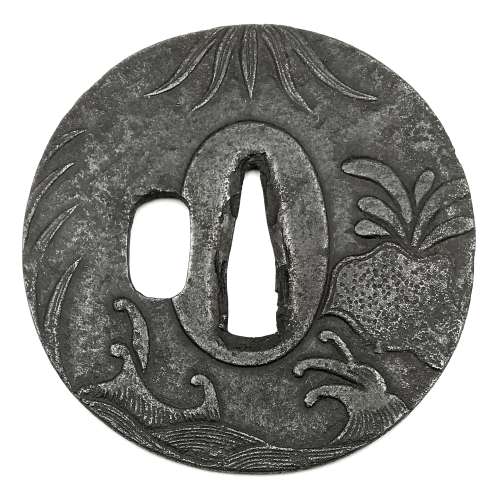 Round iron plate of grey colour decorated in low relief (sukidashi-bori) on the face with sea waves (both layered waves, seigaiha, and rough waves, araumi), sago palm (cycas revoluta, sotetsu), presumably orchid leaves (ran) - five of them - hanging from the above, and reeds (ashi), and on the back with waves (seigaiha only), rocks, chrysanthemums (kiku), clove (chori), reed, and presumably orchid leaves - three of them - hanging from the above. The kozuka-hitsu-ana was probably cut later. The plate is lacking the raised rim, typical for the kamakura-bori school. Muromachi period. Dimensions: Height: 76.8 mm, width: 76.1 mm, Thickness at seppa-dai: 3.3 mm, at rim 2.0 mm. Height of nakago-ana: 29 mm. Weight: 82.4 g. NBTHK certificate № 402152: Hozon - "Worthy of preservation". A similar (most probably the same) tsuba is illustrated and described at Butterfield & Butterfield. IMPORTANT JAPANESE SWORDS, SWORD FITTINGS AND ARMOR. Auction Monday, November 19th, 1979. Sale # 3063 under lot № 66. It describes the piece as following: “Kamakura bori work of the Muromachi period. Round thin plate with some small iron bones in the edge. Carved with design of plants (sego palm) rocks, and waves on the face. The back has half of two chrysanthemums, waves, clove, and sego palm leaves. The kozuka-hitsu has been added and later enlarged. A good typical example without the rim most have. Diameter: 7.7 cm., thickness 2.5 mm. Estimated price $100-200":
Round iron plate of grey colour decorated in low relief (sukidashi-bori) on the face with sea waves (both layered waves, seigaiha, and rough waves, araumi), sago palm (cycas revoluta, sotetsu), presumably orchid leaves (ran) - five of them - hanging from the above, and reeds (ashi), and on the back with waves (seigaiha only), rocks, chrysanthemums (kiku), clove (chori), reed, and presumably orchid leaves - three of them - hanging from the above. The kozuka-hitsu-ana was probably cut later. The plate is lacking the raised rim, typical for the kamakura-bori school. Muromachi period. Dimensions: Height: 76.8 mm, width: 76.1 mm, Thickness at seppa-dai: 3.3 mm, at rim 2.0 mm. Height of nakago-ana: 29 mm. Weight: 82.4 g. NBTHK certificate № 402152: Hozon - "Worthy of preservation". A similar (most probably the same) tsuba is illustrated and described at Butterfield & Butterfield. IMPORTANT JAPANESE SWORDS, SWORD FITTINGS AND ARMOR. Auction Monday, November 19th, 1979. Sale # 3063 under lot № 66. It describes the piece as following: “Kamakura bori work of the Muromachi period. Round thin plate with some small iron bones in the edge. Carved with design of plants (sego palm) rocks, and waves on the face. The back has half of two chrysanthemums, waves, clove, and sego palm leaves. The kozuka-hitsu has been added and later enlarged. A good typical example without the rim most have. Diameter: 7.7 cm., thickness 2.5 mm. Estimated price $100-200":
Butterfield & Butterfield, 1979. Sale # 3063, lot № 66.
-
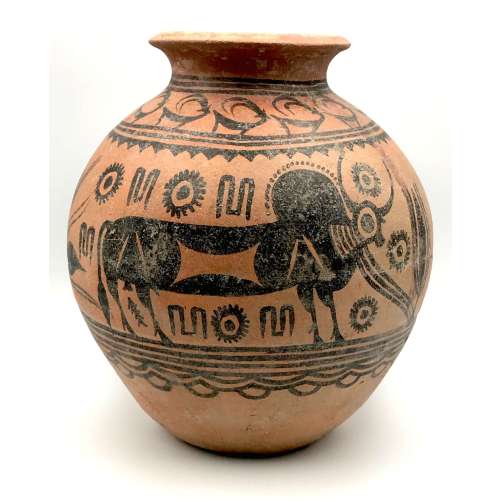 Circa 3300-2000 BC Dimensions: 184 x 165mm. Weight: 708grams
Circa 3300-2000 BC Dimensions: 184 x 165mm. Weight: 708grams


